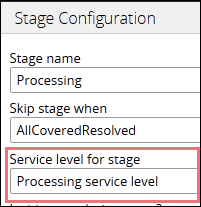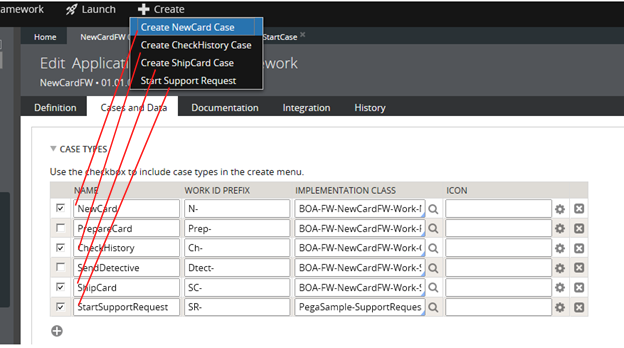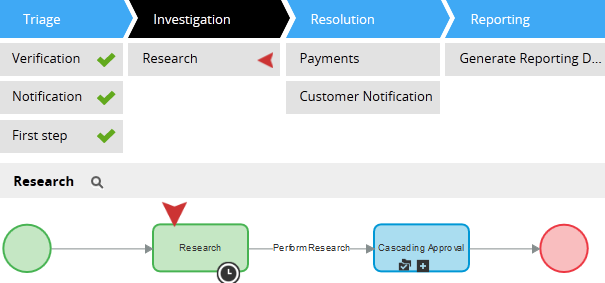Post files and links with pxPostMessage API
Valid from Pega Version 7.1.4
The pxPostMessageAPI now supports text messages, file attachments, and hyperlinks. You can programmatically update Pulse streams using this API from activities or SLA rules.
Case Management
Valid from Pega Version 7.1.4
This release has continued to focus on improving the functionality of the design environment with improvements to the Case Designer and stage configuration. Additional end user capabilities were also added to allow for processing a wider variety of cases, for those with and without stages and improved bulk processing handling.
- Flow action processing now uses the primary page instead of the interest page when using case/stage local actions, so that embedded flows are properly populated.
- Case-wide local actions rely on pzInternalStageFlow when there are no active, non-hidden assignments on the case. These case-wide local actions will now appear on a stage-less flow with no assignments.
- If a (valid) error is displayed in the outline view, saving or clicking around will not delete the error - the error will remain as a reminder to the developer to solve whatever problem is being flagged.
- May now add Cascading Approval validation and edit the parameters from the Case Designer Stage and Step page.
- Page labelling ("Page 1 of X") appears in the history list presented in the audit tab.
- The bulk processing feature has been enhanced.
- The Outline View functionality was changed so that the visible page will no longer refresh each time a flow is edited.
- The Post value was added to the instructions text field, so data isn't lost between nodes in the outline View.
- When Assign to Operator or workbasket is included as a filter, the bulk processing gadget is supposed to get a list of assignments. The UI for the results was enhanced for assignments to include a column for instructions so that the different assignments on the same work item can be distinguished.
- When designing a case type’s stages, it is no longer possible to skip the last stage (by using the "skip stage when" setting). When creating or editing the last stage, developers may no longer set a skip when rule; if tried, the system will display a warning and prevent that. If a Skip When rule is set up for a stage, and then all the intervening stages are deleted so that this stage becomes the last stage, the warning will display, and the Skip When rule will not be visible. If another stage is then added after that, the Skip When rule becomes visible again.
- When one or more locked work objects are processed using the Process Selected Items button, the action will be performed on the selected work objects. If the action is successful, a green tick appears on the work object. If it is not successful, a red cross will appear.
- When the topmost RuleSet in the RuleSet Stack is locked, customers may now open up Outline View by clicking "Configure Process Details" and make exploratory changes to experiment. Because the RuleSet is locked, these changes may not be saved, but the experiment can be tried.
Flow rules not supported in IE8
Valid from Pega Version 7.1.1
In versions prior to 7.1.2, flow rules do not open in Internet Explorer 8 (IE8). Upgrade your system to the latest version of PRPC or access flows from another supported browser.
Quickly create ad-hoc cases
Valid from Pega Version 7.1.4
The My Cases work area on the Case Manager portal introduces a Quick Create feature that lets users create cases and assign tasks that are not included in the processing of business cases (instances of case types defined in the Cases Explorer). For example, a manager can create a case and a task to set up a phone conference with her staff, or a reminder to enroll in an online seminar. Users can also set up a series of tasks to represent all they work they need to do to accomplish a specific goal.
Case Management
Valid from Pega Version 7.1.3
This release had a focus on extending key capabilities to improve the ease of configuration based on early adopter feedback. Improvements were made in run-time performance, especially in high volume situations with complex case configurations. A series of cosmetic changes and fixes are included.
- The Wait shape now supports dynamic references.
- Issues were addressed with the CreatePDF and the CascadingApproval Smartshapes.
- Attachments have been improved.
- Issues with the Create Case Type functionality were addressed.
- The Pega Pulse functionality has been improved, including its performance.
- When auditing a work item, History is now the default tab.
Service levels for case stages
Valid from Pega Version 7.1.5
Service levels are available for stages in stage-based case management applications.
The service level starts when a case enters a stage and stops when it exits. The service level is defined in the Service level for stage field on the "Stage Configuration" dialog, which is accessed on the Case Designer Stages and Processes tab.

Alternatively, you can add a stage service level on the case type record's Stages tab.
Customize your starting flow list
Valid from Pega Version 7.1.5
The Designer Studio menu now populates the list of starting flows by referencing the case types that you select (including case types in Create Menu checkbox) on the application form's Cases and Data tab. The order of the case types on the tab dictates the order of flows that appear on the menu.

Previously, the menu displayed all starting flows in the current workpool. This new feature enables you to control which flows appear on the menu.
You can change the sort order by customizing the extension activity pySortStartingFlows. For example, you can sort the flows by their short descriptions.
Where-Am-I? includes stage and step progress
Valid from Pega Version 7.1.5
In stage-based case management applications, the Where-Am-I? display includes a read-only presentation of primary stage and step shapes. Green checkmarks indicate completed steps. A red arrow indicates the current step.

Stop active processes on stage exit
Valid from Pega Version 7.1.5
The Change Stage smart shape provides a "Remove processes on exit stage" option that stops all active processes in a stage when a case leaves it. The system removes the stage's open assignments from user forms.
Standard page lists for attachments
Valid from Pega Version 7.1.5
The following new standard page lists allow you to easily reference attachments in your designs:
- pyAttachments — Holds a list of attachments of the current case.
- pyAttachmentCategoriesList — Holds a list of attachment categories of the current case. This property can be used to fetch the attachment information by category (pyAttachmentsByCategory).
- pyAttachmentsByCategory — Holds a list of attachments for the category set in the pyAttachmentCategory property in the current case.
When a user or system adds an attachment, the system automatically associates the page lists with the case, and populates them when the properties are referred to.
Creating an attachment category in a case type record automatically creates a property reference. See Redesigned Attachment Categories tab on Case Type record.
In addition, you validate the existence of an attachment by referencing the new function alias pxIsAttachmentOfCategoryInCase in a validate record. For example, you can use the properties and a validate record for building when logic that makes it necessary for a user to attach a document of category "SECCompliance" before the case can enter a stage.

